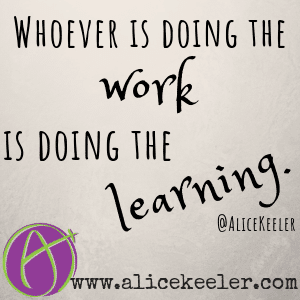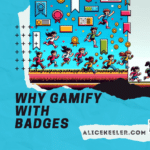Are the Students Learning or Is the Teacher?
A Guest Post by Erin Whalen
I have had the privilege of hearing Alice speak several times now, and while I have learned a LOT from her, there is one particular phrase that has really made me stop and think about my own practices. It’s sort of a gut check; the type of phrase that stirs some self-reflection and motivates me to continue improving my teaching to do what is best for kids.
“The person doing the work is the person doing the learning.” -Alice Keeler
In other words, when we DO for the students, they don’t learn to DO for themselves. Is it easier to highlight a phrase, to copy and paste, to hit CTRL+F to find a keyword, to add the missing period at the end of the sentence, etc. ourselves rather than showing the students how to do it? Probably. Is it less time-consuming to demonstrate in a stand and deliver way rather than to let them explore? Maybe. But it’s not about us. We must do what’s best for our students. Letting the students explore, question, wonder, and discover will have a profound effect on their learning in several ways.
Self-Motivation
We want our students to have a fire within them. An insatiable curiosity. A thirst for knowledge. A passion for learning. It’s often said that children are born with these qualities and schools tend to squash them. Let’s stop doing that! Let’s not light a fire under them, but keep their natural fire, their self-motivation and curiosity, burning within them. Encouraging the students to play, to practice, to take risks, and to learn from mistakes can keep them motivated and engaged in their learning.
Long-Term Retention
When students are active participants in the learning process – when they are doing research, conducting experiments, and creating content rather than just consuming it – their long-term retention of the material is far greater. This has been proven over and over again in research on education. So in addition to the positive atmosphere that comes with a student-centered classroom, this makes sense for high quality instruction. Letting the students do things for themselves, especially in collaboration with their peers, means that you understand how children learn. Learning is a social activity. Worksheets don’t foster long-term retention. Talking, thinking out loud, creating, getting messy…these are ways of getting new learning into long-term memory.
Sense of Accomplishment
One of my college professors often used the phrase, “Success breeds success.” In fact, she used it so much it was almost overkill. But it’s TRUE! It’s a phrase Alice often uses as well. [tweet]Failing grades are not motivating. A taste of success is.[/tweet] Find a way to help all your students be successful, even in small ways, and you will do far more to increase their motivation and their chances at success, than any amount of yelling, shaming, or poor grades could ever do. It’s not being soft; it’s being smart. It’s being fair and just and knowing that each of our students has great potential. Each of our students has something to say. Help them find their voice; help them find their strengths. Success breeds success.
Time to Focus on Relationships
Good teaching takes a lot of time and a lot of energy. Don’t waste your time or energy doing things the kids can do for themselves. When you free up that time, you not only help the students in all the ways mentioned above, you also give yourself time to focus on what really matters – relationships. Talk to your students. Listen to your students! You can get to know them, build relationships, and do all of your assessment while you talk to them (a tremendous bonus that could be an entire blog post on its own). You can see and hear what they are learning and what they need. You can make a positive difference in the life of each child. What’s more important than that?!
Erin is a former teacher and principal now working in professional development to support and empower teachers and administrators in the important work they do. Follow her on Twitter @e_whalen.







